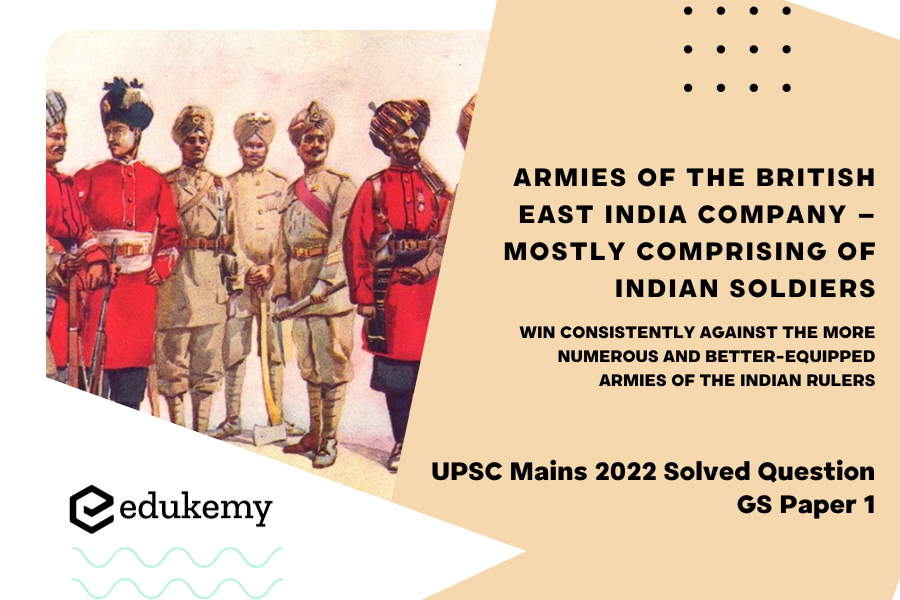The British East India Company’s armies, composed largely of Indian soldiers, prevailed over the more numerous and better-equipped forces of Indian rulers due to superior military tactics, modern weaponry, internal divisions among Indian kingdoms, and the use of advanced organizational strategies. Additionally, the British leveraged local alliances and took advantage of political instability, aiding their conquest.
UPSC Mains General Studies Paper – 1 Mains 2022
UPSC Mains Civil Services IAS Exam Question Paper – 2022
Contents
Approach
- Introducing the paramountacy regime of the British East India Company..
- Describe all the reasons behind the supremacy power of armies against the Indian rulers .
- The idea of British colonial expansion policies ,war tactics and effective strategy on the Indian rulers.
Answer
Introduction
The East India Company came to rule large areas of the Indian subcontinent, exercising military power through its formidable private army. Largely made up of native soldiers, this force also helped advance British colonial expansion further a field, a process that continued after its transformation into the Indian Army.

Body
Reasons behind the supremacy power of armies against the Indian rulers.
- Professionalism and Training: The British East India Company invested in training and discipline for their sepoys. They introduced European military tactics and modern weaponry, making their forces more organized and effective on the battlefield.
- For Example: In the Battle of Plassey (1757), the British, led by Robert Clive, employed disciplined sepoys and defeated the larger but less organised forces of Siraj-ud-Daulah, the Nawab of Bengal.
- Technological Superiority: The British had access to advanced firearms, artillery, and naval support. This technological advantage gave them an upper hand in engagements.
- For Example: During the Anglo-Maratha Wars, the British employed superior artillery and naval power, particularly in the Battle of Assaye (1803), where Arthur Wellesley (later Duke of Wellington) used well-placed cannons to break Maratha lines.
- Leadership and Strategy: British commanders often displayed better strategic planning and leadership skills, allowing them to exploit weaknesses in enemy forces.
- Alliances and Diplomacy: The British East India Company effectively used alliances with local rulers and fractions to weaken and divide their adversaries.
- For Example: In the Carnatic Wars, the British aligned with local rulers like Nawab Anwaruddin and Chanda Sahib to counter the French and their allies.
- Divide and Rule Policy: The British leveraged existing rivalries among Indian rulers to their advantage, creating disunity and facilitating their expansion.
- For Example: The Anglo-Maratha Wars saw the British exploiting divisions between different Maratha factions, weakening their united resistance.
- Logistics and Naval Support: The British Navy ensured reliable supply lines and troop transportation, enabling sustained military campaigns.
- For Example: In the Battle of Plassey, British naval superiority allowed them to reinforce their positions and maintain effective communication.
- Economic Resources: The British East India Company had access to significant financial and logistical resources, which contributed to their ability to field and maintain a well-equipped army.
- For Example: The Company’s financial strength enabled them to hire skilled European officers and equip their sepoys with modern weaponry.
Conclusion
The British Empire adopted the age-old political strategy of divide and conquer throughout their colonisation of India. The occupiers used the strategy to turn locals against each other to help them rule the region ,With effective strategy and tactics, and collaboration with local rulers allowed the armies of the British East India Company ruled here for more than 300 years.
In case you still have your doubts, contact us on 8792740517.
For UPSC Prelims Resources, Click here
For Daily Updates and Study Material:
Join our Telegram Channel – Edukemy for IAS
- 1. Learn through Videos – here
- 2. Be Exam Ready by Practicing Daily MCQs – here
- 3. Daily Newsletter – Get all your Current Affairs Covered – here
- 4. Mains Answer Writing Practice – here


